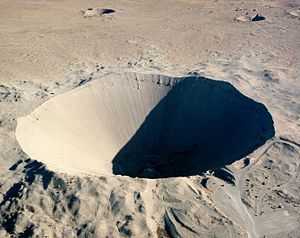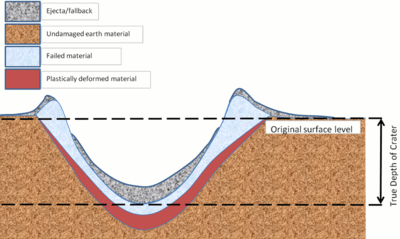Explosion crater

Crater created by the Sedan shallow underground nuclear test explosion
An explosion crater is a type of crater formed when material is ejected from the surface of the ground by an explosive event at or immediately above or below the surface.

Stylised cross-section of a crater formed by a below-ground explosion.
A crater is formed by an explosive event through the displacement and ejection of material from the ground. It is typically bowl-shaped. High-pressure gas and shock waves cause three processes responsible for the creation of the crater:
- Plastic deformation of the ground.
- Projection of material (ejecta) from the ground by the explosion.
- Spallation of the ground surface.
Two processes partially fill the crater back in:
- Fall-back of ejecta.
- Erosion and landslides of the crater lip and wall.[1]
The relative importance of the five processes varies, depending on the height above or depth below the ground surface at which the explosion occurs and on the composition of the ground.
References
- ↑ P. W. Cooper. Explosives Engineering. Wiley-VCH. ISBN 0-471-18636-8
See also
- Maar, a crater caused by a volcanic explosion
- Pseudocrater, a volcanic crater formed by a steam explosion
- Subsidence crater, a depression in the ground formed by collapse of a void below the surface
- Impact crater, a depression formed by excavation following a hypervelocity impact